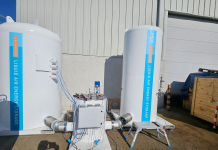Scots universities & SP Energy Networks are teaming up to develop an AI-enabled ‘digital twin’ of the nation’s power networks.
In a British first, UK Research & Innovation’s engineering & physics offshoot has awarded £10 million to aid development of a learning testbed, replicating in detail the UK’s grid and the near-countless power flows across it.
Scenario testing of answers to investment dilemmas, work-arounds for choke points, optimising a grid changed out of recognition and predicting changed behaviours directing new investment options, are all goals of the ENSIGN project, an acronym of ‘ENergy System dIGital twiN’.
Developed in collaboration with four universities – Strathclyde, Glasgow, Heriot Watt and St Andrews – ENSGIN will help identify the best ways to optimise capacity and incorporate green energy technologies on to the network as homes and businesses make the switch to cleaner and greener fuels on the road to net zero emissions.
Hosted by the University of Strathclyde, the ground-breaking project will seek best options for managing increased electricity demand. Demand will grow as homes and industry switch to renewables-intensive power & hydrogen to replace for high-carbon gas
Modelling from Strathclyde’s sister unis will allow SP Energy Networks to identify best practice and real-life solutions, ready for deployment to ensure tomorrow’s reliable, resilient and cost-effective grids.
The pioneering project is earmarked as a first step to revolutionary changes for UK consumers. ENISGN’s ‘digital twin’ will create new virtual links between homes and businesses and the grid.
These will be the first stage in creating a new digital layer to Britain’s future smart grid. Cleverer networks will empower consumers – or ENSIGN’s backers hope – to interact more closely their supply, either in person or through intelligent household devices. Energy retailers will be able to offer better information and services to homeowners.
Running till 2028, the programme will support twenty new research jobs in the sponsoring academies.
“The pace of change in the energy industry is like nothing we’ve ever seen”, observed Scott Mathieson, SP’s network planning director.
“It’s vital we can stress-test tech and services to identify the best solutions and ensure the network remains fit for purpose as we move towards an all-electric future.
“This new ‘digital twin’ will allow us to simulate innovations and understand the potential benefits of new services in a whole new light, giving us meaningful insights that will directly impact what we do in the real world.
“The insights from this project will help shape the future of the energy system in the UK and offer the potential to transform the energy grids of countries around the world. Having the support of the Prosperity Partnership enables us to drive this industry-leading project to create a cleaner, greener and better future, quicker, for everyone.”
From Strathclyde’s engineering department, Professor Campbell Booth added: “This partnership will create a system-Digital Twin to facilitate resilient, affordable, low-carbon energy systems of the future.
“It will create the knowledge, visibility and applications that are urgently required for accurate and informed decision-making, risk management, and various other functions that will be required for effective planning, design and operation of future energy systems.”
Once complete, the project’s findings are expected to be rolled-out to other distribution network operators across the UK and further afield.



